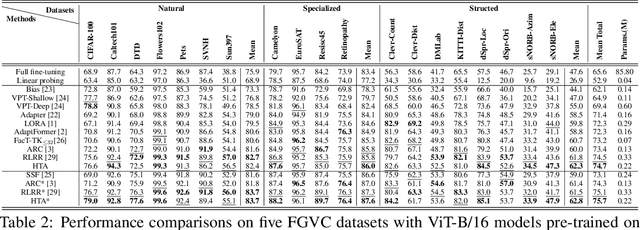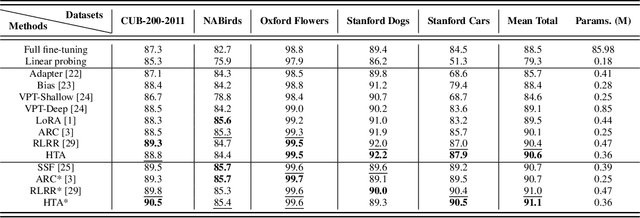Xing Zhang
MiMo-Audio: Audio Language Models are Few-Shot Learners
Dec 29, 2025Abstract:Existing audio language models typically rely on task-specific fine-tuning to accomplish particular audio tasks. In contrast, humans are able to generalize to new audio tasks with only a few examples or simple instructions. GPT-3 has shown that scaling next-token prediction pretraining enables strong generalization capabilities in text, and we believe this paradigm is equally applicable to the audio domain. By scaling MiMo-Audio's pretraining data to over one hundred million of hours, we observe the emergence of few-shot learning capabilities across a diverse set of audio tasks. We develop a systematic evaluation of these capabilities and find that MiMo-Audio-7B-Base achieves SOTA performance on both speech intelligence and audio understanding benchmarks among open-source models. Beyond standard metrics, MiMo-Audio-7B-Base generalizes to tasks absent from its training data, such as voice conversion, style transfer, and speech editing. MiMo-Audio-7B-Base also demonstrates powerful speech continuation capabilities, capable of generating highly realistic talk shows, recitations, livestreaming and debates. At the post-training stage, we curate a diverse instruction-tuning corpus and introduce thinking mechanisms into both audio understanding and generation. MiMo-Audio-7B-Instruct achieves open-source SOTA on audio understanding benchmarks (MMSU, MMAU, MMAR, MMAU-Pro), spoken dialogue benchmarks (Big Bench Audio, MultiChallenge Audio) and instruct-TTS evaluations, approaching or surpassing closed-source models. Model checkpoints and full evaluation suite are available at https://github.com/XiaomiMiMo/MiMo-Audio.
LLM Enabled Multi-Agent System for 6G Networks: Framework and Method of Dual-Loop Edge-Terminal Collaboration
Sep 05, 2025Abstract:The ubiquitous computing resources in 6G networks provide ideal environments for the fusion of large language models (LLMs) and intelligent services through the agent framework. With auxiliary modules and planning cores, LLM-enabled agents can autonomously plan and take actions to deal with diverse environment semantics and user intentions. However, the limited resources of individual network devices significantly hinder the efficient operation of LLM-enabled agents with complex tool calls, highlighting the urgent need for efficient multi-level device collaborations. To this end, the framework and method of the LLM-enabled multi-agent system with dual-loop terminal-edge collaborations are proposed in 6G networks. Firstly, the outer loop consists of the iterative collaborations between the global agent and multiple sub-agents deployed on edge servers and terminals, where the planning capability is enhanced through task decomposition and parallel sub-task distribution. Secondly, the inner loop utilizes sub-agents with dedicated roles to circularly reason, execute, and replan the sub-task, and the parallel tool calling generation with offloading strategies is incorporated to improve efficiency. The improved task planning capability and task execution efficiency are validated through the conducted case study in 6G-supported urban safety governance. Finally, the open challenges and future directions are thoroughly analyzed in 6G networks, accelerating the advent of the 6G era.
Repeating Words for Video-Language Retrieval with Coarse-to-Fine Objectives
Aug 20, 2025Abstract:The explosive growth of video streaming presents challenges in achieving high accuracy and low training costs for video-language retrieval. However, existing methods rely on large-scale pre-training to improve video retrieval performance, resulting in significant computational demands. Additionally, the fine-grained information in videos and texts remains underexplored. To alleviate these problems, we propose a novel framework to learn fine-grained features for better alignment and introduce an inference pipeline to improve performance without additional training. Specifically, we employ coarse-to-fine objectives to understand the semantic information of video-text pairs, including contrastive and matching learning. The fine-grained data used for training is obtained through the Granularity-Aware Representation module, which is designed based on similarity analysis between video frames and words in captions. Furthermore, we observe that the repetition of keywords in the original captions, referred to as "Repetition", can enhance retrieval performance and improve alignment between video and text. Based on this insight, we propose a novel and effective inference pipeline that incorporates a voting mechanism and a new Matching Entropy metric to achieve better retrieval performance without requiring additional pre-training. Experimental results on four benchmarks demonstrate that the proposed method outperforms previous approaches. Additionally, our inference pipeline achieves significant performance improvements, with a 2.1% increase in Recall@1 on the MSR-VTT dataset and a 1.6% increase on the DiDeMo dataset.
MiMo: Unlocking the Reasoning Potential of Language Model -- From Pretraining to Posttraining
May 12, 2025Abstract:We present MiMo-7B, a large language model born for reasoning tasks, with optimization across both pre-training and post-training stages. During pre-training, we enhance the data preprocessing pipeline and employ a three-stage data mixing strategy to strengthen the base model's reasoning potential. MiMo-7B-Base is pre-trained on 25 trillion tokens, with additional Multi-Token Prediction objective for enhanced performance and accelerated inference speed. During post-training, we curate a dataset of 130K verifiable mathematics and programming problems for reinforcement learning, integrating a test-difficulty-driven code-reward scheme to alleviate sparse-reward issues and employing strategic data resampling to stabilize training. Extensive evaluations show that MiMo-7B-Base possesses exceptional reasoning potential, outperforming even much larger 32B models. The final RL-tuned model, MiMo-7B-RL, achieves superior performance on mathematics, code and general reasoning tasks, surpassing the performance of OpenAI o1-mini. The model checkpoints are available at https://github.com/xiaomimimo/MiMo.
AnimeDL-2M: Million-Scale AI-Generated Anime Image Detection and Localization in Diffusion Era
Apr 15, 2025



Abstract:Recent advances in image generation, particularly diffusion models, have significantly lowered the barrier for creating sophisticated forgeries, making image manipulation detection and localization (IMDL) increasingly challenging. While prior work in IMDL has focused largely on natural images, the anime domain remains underexplored-despite its growing vulnerability to AI-generated forgeries. Misrepresentations of AI-generated images as hand-drawn artwork, copyright violations, and inappropriate content modifications pose serious threats to the anime community and industry. To address this gap, we propose AnimeDL-2M, the first large-scale benchmark for anime IMDL with comprehensive annotations. It comprises over two million images including real, partially manipulated, and fully AI-generated samples. Experiments indicate that models trained on existing IMDL datasets of natural images perform poorly when applied to anime images, highlighting a clear domain gap between anime and natural images. To better handle IMDL tasks in anime domain, we further propose AniXplore, a novel model tailored to the visual characteristics of anime imagery. Extensive evaluations demonstrate that AniXplore achieves superior performance compared to existing methods. Dataset and code can be found in https://flytweety.github.io/AnimeDL2M/.
MQADet: A Plug-and-Play Paradigm for Enhancing Open-Vocabulary Object Detection via Multimodal Question Answering
Feb 26, 2025Abstract:Open-vocabulary detection (OVD) is a challenging task to detect and classify objects from an unrestricted set of categories, including those unseen during training. Existing open-vocabulary detectors are limited by complex visual-textual misalignment and long-tailed category imbalances, leading to suboptimal performance in challenging scenarios. To address these limitations, we introduce MQADet, a universal paradigm for enhancing existing open-vocabulary detectors by leveraging the cross-modal reasoning capabilities of multimodal large language models (MLLMs). MQADet functions as a plug-and-play solution that integrates seamlessly with pre-trained object detectors without substantial additional training costs. Specifically, we design a novel three-stage Multimodal Question Answering (MQA) pipeline to guide the MLLMs to precisely localize complex textual and visual targets while effectively enhancing the focus of existing object detectors on relevant objects. To validate our approach, we present a new benchmark for evaluating our paradigm on four challenging open-vocabulary datasets, employing three state-of-the-art object detectors as baselines. Experimental results demonstrate that our proposed paradigm significantly improves the performance of existing detectors, particularly in unseen complex categories, across diverse and challenging scenarios. To facilitate future research, we will publicly release our code.
Skeleton-Guided-Translation: A Benchmarking Framework for Code Repository Translation with Fine-Grained Quality Evaluation
Jan 27, 2025



Abstract:The advancement of large language models has intensified the need to modernize enterprise applications and migrate legacy systems to secure, versatile languages. However, existing code translation benchmarks primarily focus on individual functions, overlooking the complexities involved in translating entire repositories, such as maintaining inter-module coherence and managing dependencies. While some recent repository-level translation benchmarks attempt to address these challenges, they still face limitations, including poor maintainability and overly coarse evaluation granularity, which make them less developer-friendly. We introduce Skeleton-Guided-Translation, a framework for repository-level Java to C# code translation with fine-grained quality evaluation. It uses a two-step process: first translating the repository's structural "skeletons", then translating the full repository guided by these skeletons. Building on this, we present TRANSREPO-BENCH, a benchmark of high quality open-source Java repositories and their corresponding C# skeletons, including matching unit tests and build configurations. Our unit tests are fixed and can be applied across multiple or incremental translations without manual adjustments, enhancing automation and scalability in evaluations. Additionally, we develop fine-grained evaluation metrics that assess translation quality at the individual test case level, addressing traditional binary metrics' inability to distinguish when build failures cause all tests to fail. Evaluations using TRANSREPO-BENCH highlight key challenges and advance more accurate repository level code translation.
Efficient Adaptation of Pre-trained Vision Transformer via Householder Transformation
Oct 30, 2024



Abstract:A common strategy for Parameter-Efficient Fine-Tuning (PEFT) of pre-trained Vision Transformers (ViTs) involves adapting the model to downstream tasks by learning a low-rank adaptation matrix. This matrix is decomposed into a product of down-projection and up-projection matrices, with the bottleneck dimensionality being crucial for reducing the number of learnable parameters, as exemplified by prevalent methods like LoRA and Adapter. However, these low-rank strategies typically employ a fixed bottleneck dimensionality, which limits their flexibility in handling layer-wise variations. To address this limitation, we propose a novel PEFT approach inspired by Singular Value Decomposition (SVD) for representing the adaptation matrix. SVD decomposes a matrix into the product of a left unitary matrix, a diagonal matrix of scaling values, and a right unitary matrix. We utilize Householder transformations to construct orthogonal matrices that efficiently mimic the unitary matrices, requiring only a vector. The diagonal values are learned in a layer-wise manner, allowing them to flexibly capture the unique properties of each layer. This approach enables the generation of adaptation matrices with varying ranks across different layers, providing greater flexibility in adapting pre-trained models. Experiments on standard downstream vision tasks demonstrate that our method achieves promising fine-tuning performance.
AutoTVG: A New Vision-language Pre-training Paradigm for Temporal Video Grounding
Jun 11, 2024



Abstract:Temporal Video Grounding (TVG) aims to localize a moment from an untrimmed video given the language description. Since the annotation of TVG is labor-intensive, TVG under limited supervision has accepted attention in recent years. The great success of vision-language pre-training guides TVG to follow the traditional "pre-training + fine-tuning" paradigm, however, the pre-training process would suffer from a lack of temporal modeling and fine-grained alignment due to the difference of data nature between pre-train and test. Besides, the large gap between pretext and downstream tasks makes zero-shot testing impossible for the pre-trained model. To avoid the drawbacks of the traditional paradigm, we propose AutoTVG, a new vision-language pre-training paradigm for TVG that enables the model to learn semantic alignment and boundary regression from automatically annotated untrimmed videos. To be specific, AutoTVG consists of a novel Captioned Moment Generation (CMG) module to generate captioned moments from untrimmed videos, and TVGNet with a regression head to predict localization results. Experimental results on Charades-STA and ActivityNet Captions show that, regarding zero-shot temporal video grounding, AutoTVG achieves highly competitive performance with in-distribution methods under out-of-distribution testing, and is superior to existing pre-training frameworks with much less training data.
Logic Synthesis with Generative Deep Neural Networks
Jun 07, 2024



Abstract:While deep learning has achieved significant success in various domains, its application to logic circuit design has been limited due to complex constraints and strict feasibility requirement. However, a recent generative deep neural model, "Circuit Transformer", has shown promise in this area by enabling equivalence-preserving circuit transformation on a small scale. In this paper, we introduce a logic synthesis rewriting operator based on the Circuit Transformer model, named "ctrw" (Circuit Transformer Rewriting), which incorporates the following techniques: (1) a two-stage training scheme for the Circuit Transformer tailored for logic synthesis, with iterative improvement of optimality through self-improvement training; (2) integration of the Circuit Transformer with state-of-the-art rewriting techniques to address scalability issues, allowing for guided DAG-aware rewriting. Experimental results on the IWLS 2023 contest benchmark demonstrate the effectiveness of our proposed rewriting methods.
 Add to Chrome
Add to Chrome Add to Firefox
Add to Firefox Add to Edge
Add to Edge